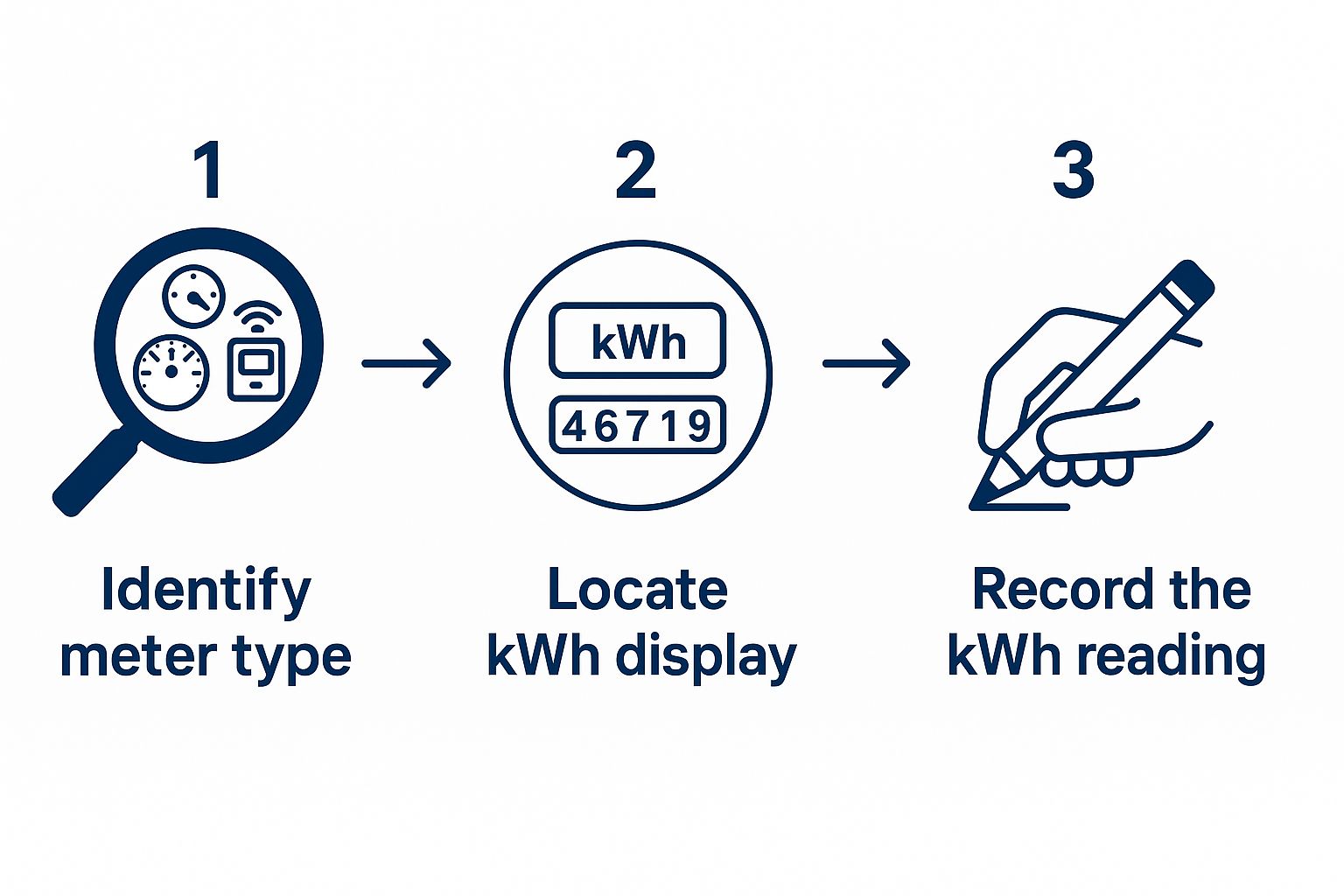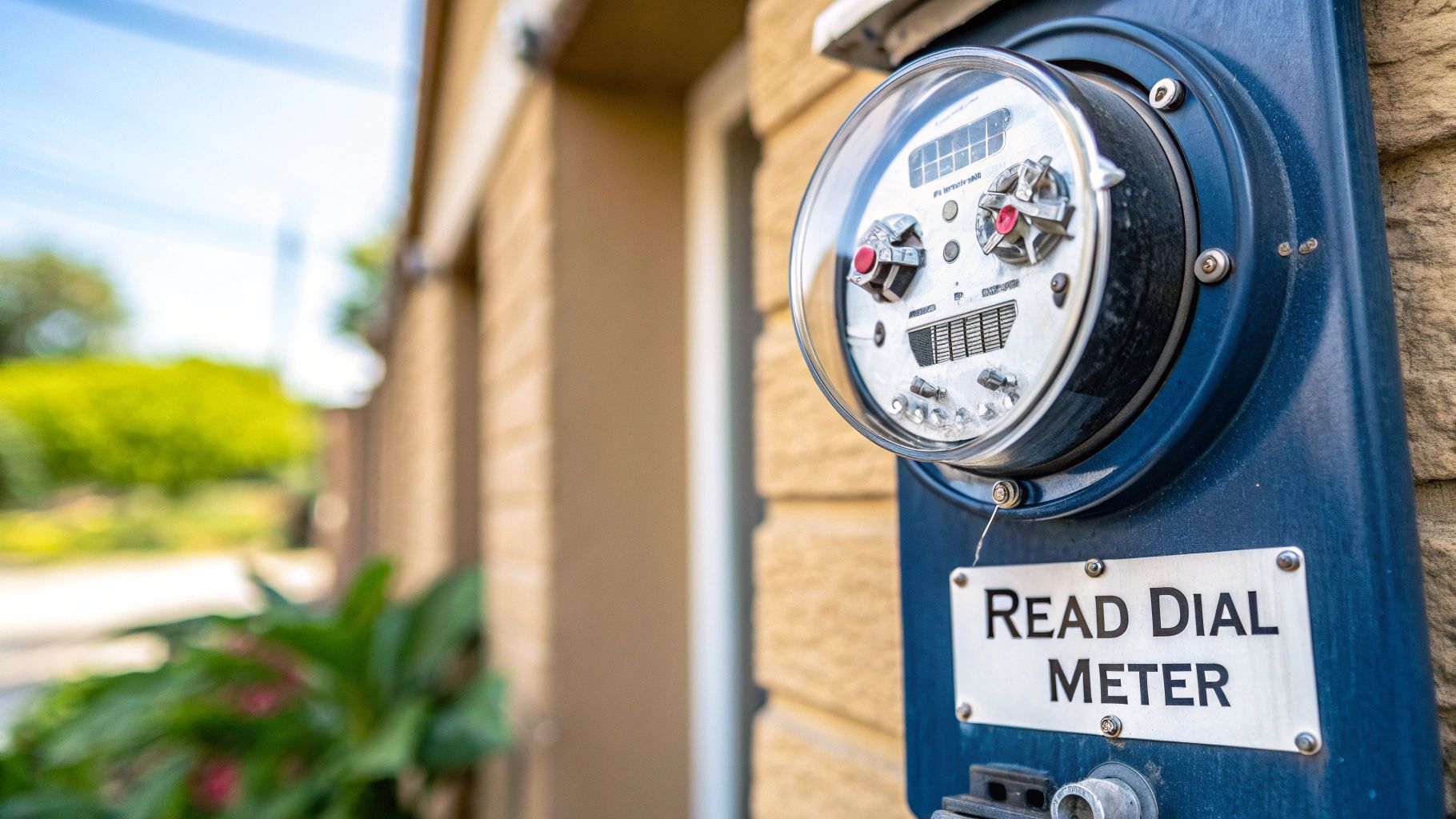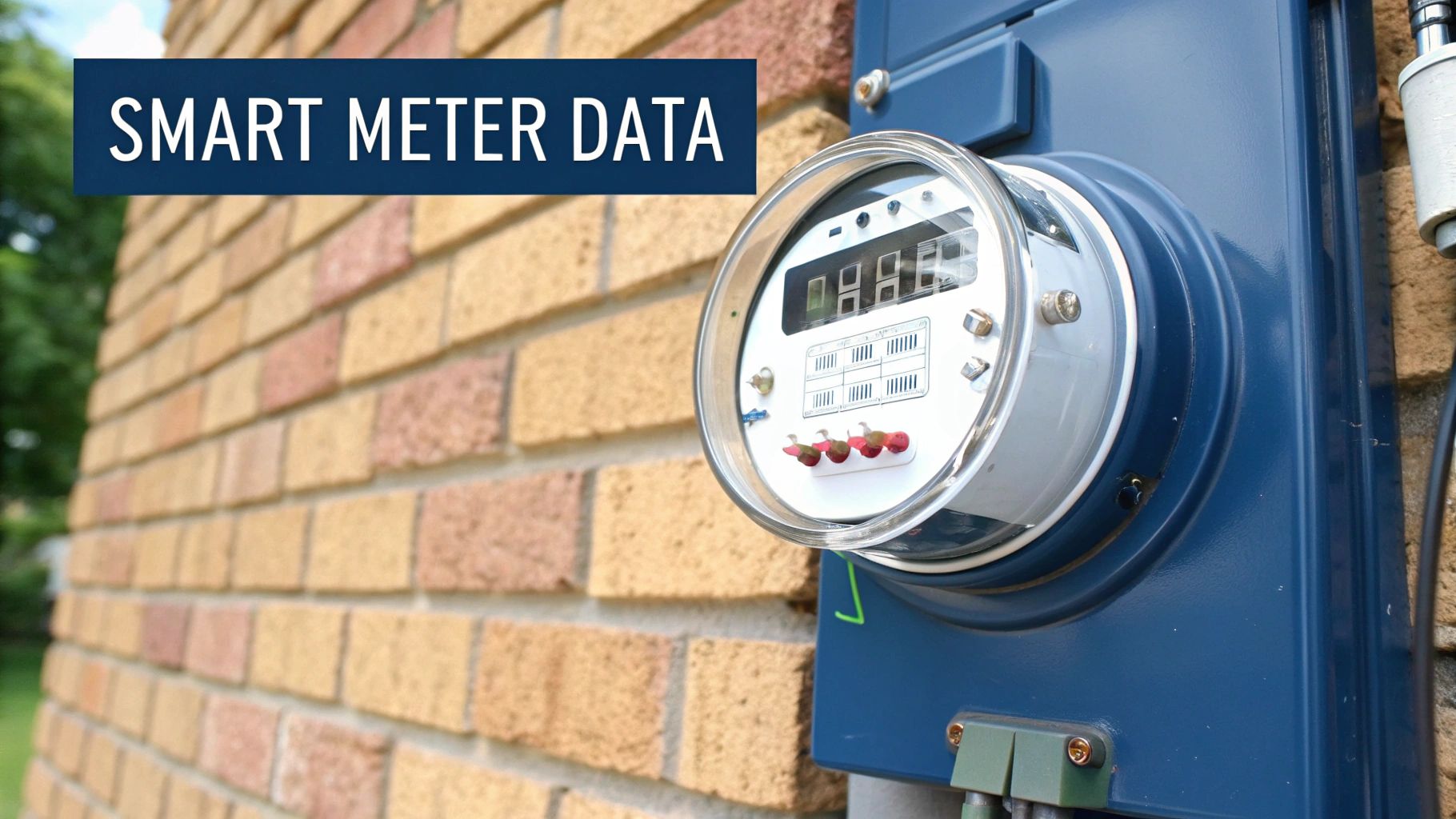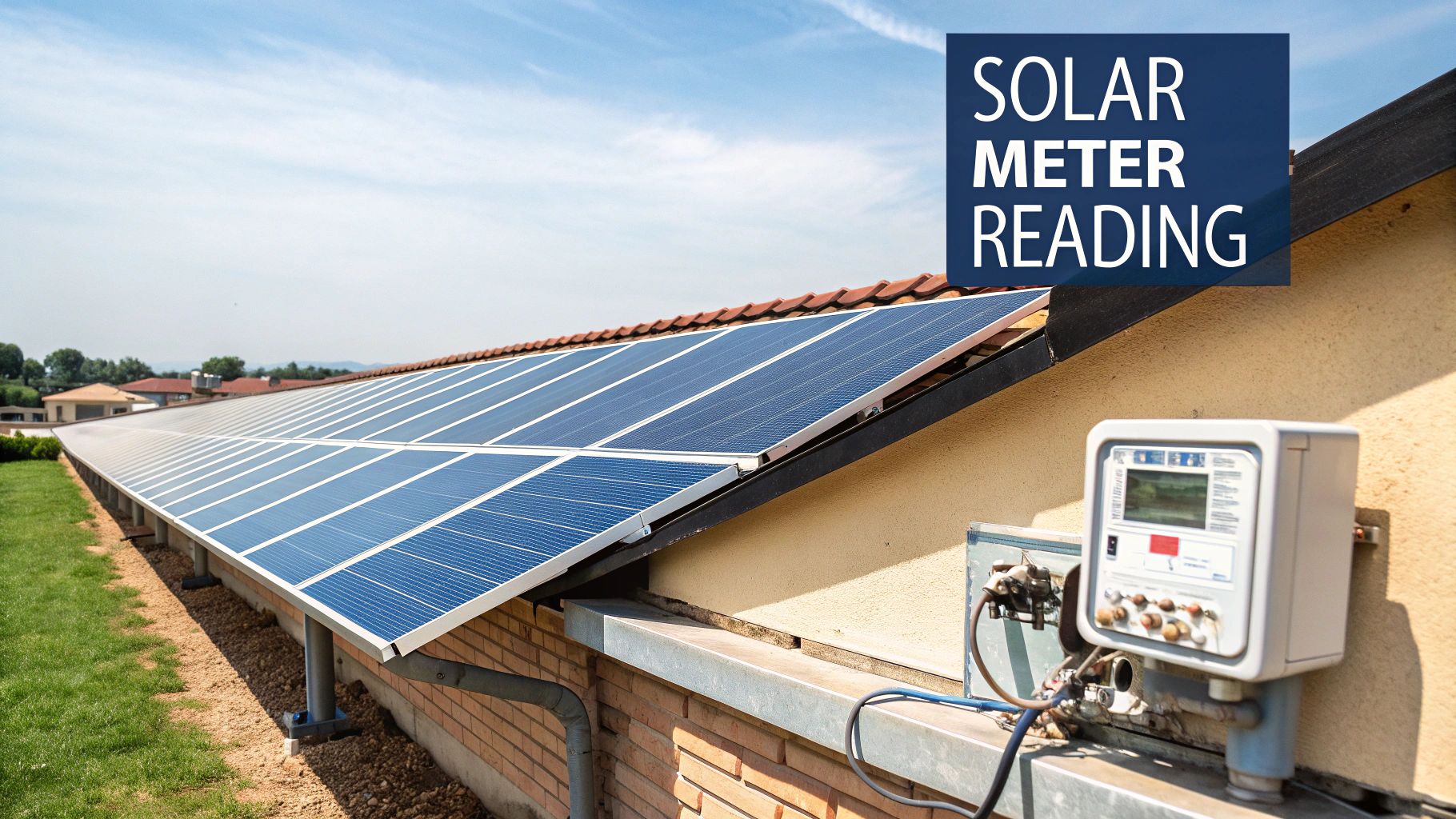How to Read Electric Meter in Australia: Easy Guide
Learning how to read your own power meter is one of those small skills that pays off big. It's the difference between blindly accepting your electricity bill and actually understanding what’s driving your costs. Once you get the hang of it, you can check your own usage, spot any weird discrepancies, and see exactly how your daily habits translate into kilowatt-hours.
This is especially handy if you’re trying to get household expenses under control. By keeping an eye on your meter, you can:
- Figure out which appliances are the real energy hogs in near real-time.
- Double-check that your energy retailer's bill is accurate, particularly if they’ve had to estimate a read.
- Make smarter decisions about when to run the dishwasher or washing machine, especially if you’re on a time-of-use tariff.
No matter what kind of meter you have clipped to the side of your house, the core task is always the same.

You just need to identify the meter type, locate the reading, and jot it down. It really is that straightforward.
The Big Shift to Smart Meters
The way we interact with our meters is changing right across Australia. The old-school approach of waiting for a meter reader to show up is on its way out, replaced by the rollout of smart meters that send your usage data automatically.
Victoria and Tasmania have pretty much finished their upgrades, and other states are on track to wrap things up by 2030. This means most of us will soon have our energy usage sent directly to our provider without anyone needing to step foot on the property. If you want to dive deeper into the national rollout, the Energy Consumers Australia website is a great resource. This shift makes getting accurate, timely data on your power consumption easier than ever.
Reading Older Dial and Digital Meters
Even though smart meters are rolling out everywhere, plenty of Australian homes still have the classic dial (analogue) or basic digital meters. These older units are workhorses and perfectly reliable, but you need to read them manually. Knowing how to do it yourself is a brilliant skill for double-checking your bills and keeping a close eye on your power usage.

Let's tackle the dial meter first. It can look a bit intimidating with all those little clock faces, but a few simple rules make it surprisingly straightforward.
Decoding the Dials
Here’s the most important trick to reading a dial meter: you have to read the dials from right to left. It feels completely backwards, I know, but it’s the only way to get it right because each dial's position affects the one next to it. You’ll also notice the dials alternate direction—one spins clockwise, the next anti-clockwise.
Here's how to get an accurate reading, step-by-step:
- Start on the right: Look at the dial on the far right and note down the number the pointer has just passed.
- Always take the lower number: If a pointer is sitting between two numbers, say a 4 and a 5, you always record the lower one. In this case, 4.
- The '9 to 0' rule: This is the one that trips people up. If a pointer is sitting exactly on a number, glance at the dial to its immediate right. If that dial's pointer has gone past 0, you can record the number the first pointer is on. But if it hasn't passed 0 yet, you have to record the previous, lower number. For example, if a dial points dead on 5 but the dial to its right is on 9, you would actually record that 5 as a 4.
The most common mistake is reading the dials from left to right like a book. This almost always gives you the wrong number because the dials on the right determine the final value of the ones on the left. Always, always start from the right and work your way across.
Reading Basic Digital Meters
Got an older digital meter without any of the smart tech? The good news is, reading it is much easier. These usually have a simple LCD screen that shows your energy consumption in kilowatt-hours (kWh).
Unlike modern smart meters that cycle through different tariff rates, these basic models typically show one main reading or flick through a couple of screens.
- Find the kWh reading: Look for the number on the screen followed by "kWh". That’s your total consumption figure.
- Ignore the other numbers: The display might flash other stuff like a segment check (where all the 8s light up), a test screen, or the meter ID. Your job is to focus only on the kWh value.
- Write it down: Simply copy down the numbers you see from left to right. If there’s a decimal point, you can ignore any digits that come after it. So, if the screen shows
0014821.6 kWh, your reading is 14821.
By taking a quick reading just before your billing cycle ends, you can compare your number with what’s on your bill. This is especially handy for checking the accuracy of an 'estimated read' from your retailer when they couldn't get to your meter. It’s a simple way to stay in control of your own energy data.
Getting the Most from Your Smart Meter
Smart meters are a world away from the old spinning-disc models. Instead of a single, ever-climbing number, they give you a real-time window into your home’s energy habits. Learning to read one is the key to actively managing your electricity costs, particularly if you're on a time-of-use tariff.
The real power is in the detail. Most smart meters have a button that lets you cycle through different screens, showing you precisely how much energy you’re using during peak, off-peak, and shoulder periods.

This is the information that lets you take control. Once you can see exactly when your power is most expensive, you can make simple changes to shift your big energy users into cheaper time slots.
Decoding Your Smart Meter Display
While the exact model in your meter box might vary, the way you navigate the display is usually pretty similar. You'll find a 'display' or scroll button that takes you through the different readings.
Here’s a quick guide to what you’re looking for:
- Total Consumption: This is the big one—the overall kilowatt-hour (kWh) reading that mirrors what you’d see on an older meter. It’s your total usage since installation.
- Time-of-Use Tariffs: This is where the savings are found. The meter will display separate readings for each tariff period, often with a small code. You might see "01" or "T1" for peak usage, "02" or "T2" for off-peak, and "03" or "T3" for the shoulder period.
- Date and Time: A quick but important check to make sure your meter is logging your usage against the correct tariff windows.
- Signal Strength: Most smart meters have a small icon showing how well they are communicating with your energy retailer.
By jotting down the readings for each tariff, you can start to see your home's energy rhythm. It quickly becomes clear how running the dishwasher at 10 pm (off-peak) instead of 7 pm (peak) can make a real difference to your next bill.
Smart meters turn you from a passive energy consumer into an active manager of your home's efficiency. The data they serve up is your best tool for spotting savings and shrinking your energy footprint.
The Growing Smart Meter Network
The move to smart meters isn't just a minor upgrade; it's a fundamental rewiring of Australia's energy infrastructure. The market here is tipped to grow at a Compound Annual Growth Rate (CAGR) of 12.3% between 2025 and 2034. That rapid uptake is being driven by people wanting more control over their bills and a push for a more sustainable grid. You can read more about the market growth forecast on marketresearch.com.
This connected network is also the foundation for more advanced energy solutions. For instance, the detailed, real-time data from a smart meter is essential for programs that pay you to share your stored solar energy. If you have a home battery, you might be interested in how a virtual power plant in Australia can help you earn extra income from your system. These programs rely on the precise data that only a smart meter can provide to help build a cleaner, more resilient grid for everyone.
How to Read a Meter with Solar Panels
Once you have solar panels, your electricity meter stops being a simple one-way street. It becomes a two-way hub, tracking the power you pull from the grid and, more importantly, the excess energy you send back.
Getting your head around this is the key to checking you're getting the right credits for your solar exports and actually making the most of your system.

Your meter is now keeping two separate tallies. One is for import, which is the grid power you buy when your panels aren't producing, like overnight. The other is for export—the surplus energy your system generates and feeds back to the grid, earning you a feed-in tariff credit on your bill.
Distinguishing Import From Export
The main trick to reading a solar-compatible meter is knowing how to find these two different readings. On a modern smart meter, it’s usually pretty straightforward. You just need to press the scroll or display button to cycle through the different screens until the import and export values pop up.
You’ll want to look for specific labels on the screen:
- Imported Energy: This is your standard consumption reading, the electricity you've paid for. It might be labelled "Import," "IMP," or even "Total Active Import." Sometimes it’s just shown with a display code like "01" or "03".
- Exported Energy: This is the important one for solar owners—the energy you’ve sold back. Look for labels like "Export," "EXP," "Total Active Export," or a code like "02" or "07". This is the number that drives your feed-in tariff credits.
Jotting down the export reading each month lets you track exactly how much your system is contributing to the grid. It’s the easiest way to cross-reference the credits you see on your electricity bill and make sure everything adds up.
Knowing how to find your export value is empowering. It turns your solar system from something that just sits on the roof into a measurable asset. You can finally confirm you're getting paid correctly for every single kilowatt-hour you send back.
Practical Tips for Solar Households
Once you’re comfortable finding both readings, you can start making much smarter decisions about your energy use.
See that you're exporting a huge amount of power in the middle of the day? That’s the perfect time to run the dishwasher, washing machine, or pool pump. This is what's known as self-consumption, and it’s a game-changer. You're using your own free solar power instead of selling it for a small credit, only to buy expensive grid power back later in the evening.
This hands-on approach is how you get the real value out of a quality solar installation. By actively monitoring your import and export data, you can seriously cut down the amount of energy you need to buy from the grid. That’s the fastest way to shrink your power bills and get the best possible return on your solar investment.
Connecting Your Meter Reading to Your Bill
A number flickering on your meter screen doesn’t mean much on its own. It only comes to life when you see how it translates into dollars and cents on your electricity bill.
This is the moment where you connect the dots, giving you the power to see exactly what you’re paying for. Once you learn to decode your bill, you can spot trends, verify the charges are correct, and feel much more in control of your energy spending.
The heart of your bill is simple maths: your usage, measured in kilowatt-hours (kWh), is multiplied by your tariff rate. Any Australian electricity bill will show the start and end readings for that billing period. If you have an older accumulation meter, you’ll just see one set of numbers. With a smart meter and a time-of-use plan, you’ll see separate readings for peak, off-peak, and shoulder periods.
Decoding Common Australian Tariffs
The type of tariff you're on dictates how your kWh usage is charged. Each one is designed for different lifestyles, so understanding yours is the key to making sense of your bill.
- Single Rate Tariff: This is the most straightforward setup. All the electricity you use is charged at one flat rate per kWh, no matter what time of day it is. Simple.
- Time of Use (ToU) Tariff: This is more dynamic. Your electricity price changes throughout the day. You’ll pay a premium during peak hours (usually late afternoon and early evening), less during off-peak hours (overnight), and a middle-of-the-road rate during shoulder periods.
- Controlled Load Tariff: This is a separate, much cheaper rate specifically for high-draw appliances like a hot water system. It’s metered separately and usually only kicks in during off-peak times.
Your bill should break down your usage for each tariff, showing the kWh you’ve consumed and the rate it was charged at. Checking these figures against your own meter readings is the best way to make sure everything lines up.
Linking Meter Data to Your Household's Energy Patterns
Understanding household energy use is getting more complex, but also more powerful. In a recent project, the Australian Energy Market Operator (AEMO) linked electricity and gas meter data for the first time across 3 million customers in states like NSW and Victoria. This just goes to show how valuable it is to see the complete picture of a home's energy habits. You can read more about these insights into residential energy patterns on the AEMO website.
By matching your meter readings to your bill, you gain real visibility into your consumption habits. You're no longer just a passive bill-payer; you become an active manager of your home's energy.
This is where it gets practical. Seeing the data allows you to understand the real financial impact of your habits. For example, if your bill shows painfully high peak usage, you can make a conscious effort to shift running the dishwasher or washing machine to off-peak times.
Seeing those changes reflected in lower costs on your next bill is incredibly motivating. It proves that small adjustments can lead to significant long-term savings. If you want to see how these small changes can add up, our online energy savings calculator is a handy tool to forecast how much you could trim from your power bills.
Common Questions About Reading Your Meter
Even when you get the hang of reading your meter, a few questions always seem to surface. Once you have the answers, you're truly in control of your home's energy data. Let's clear up a few of the most common ones.
How Often Should I Read My Electric Meter?
If you have an older analogue or basic digital meter, checking it once a month is a great habit. A quick read just before your bill is due lets you compare your numbers with what your retailer charges you for. It's especially handy if they've had to fall back on an estimated read.
With a smart meter, you don’t technically need to read it for billing, but a quick glance every now and then can tell you a lot. It’s a great way to understand your daily energy patterns, particularly if you're trying to trim costs on a time-of-use plan.
What Do the Different Codes on My Meter Mean?
Those codes cycling across your digital meter’s screen are just different slices of data. For example, you might see 'T1' for your peak usage, 'T2' for off-peak, and 'T3' for the shoulder period between them.
There will always be a code for your total consumption. If you have solar panels, you’ll see another one tracking the energy you've exported back to the grid.
Your energy retailer's website is the best place to find a guide for your specific model; they usually have clear explanations for every code.
What's an NMI? Think of the National Metering Identifier (NMI) as the unique street address for your electricity connection. It's a 10 or 11-digit number you'll find on your bill, and it’s different from the serial number printed on the meter itself. Your retailer uses the NMI to make sure they're billing the right supply point.
Why Does My Meter Reading Not Match My Bill?
A mismatch between your meter and your bill usually has a simple explanation.
The most common reason is an 'estimated read'. If your retailer couldn't get a clear reading (maybe a locked gate or a dog in the yard), they'll estimate your usage. They'll correct it on the next actual reading, but it can cause a surprise bill.
Also, check the dates. Your bill only covers usage up to a certain day. If you read your meter a week later, the number will naturally be higher. If the difference is huge and you can't account for it with new appliances or habits, it's worth giving your retailer a call to double-check their numbers.
At HighFlow Connect, we help Australian households get more value from their solar and battery systems. By joining our flexible Virtual Power Plant, you can earn extra income from your stored energy, reduce your reliance on the grid, and gain greater control over your power bills. Learn more about our smart energy solutions at https://highflowconnect.com.au.


